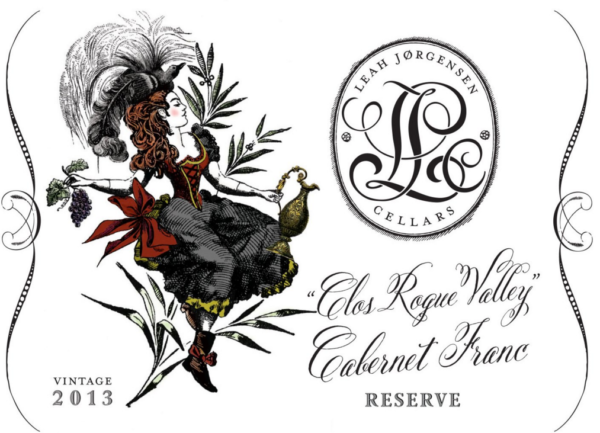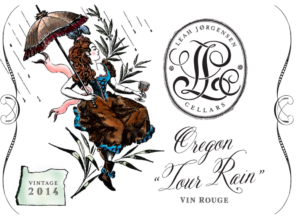
Clos Rogue Valley – Cabernet Franc Reserve
$1.00
| Country | USA |
|---|---|
| Region | Oregon |
| Producer | Leah Jorgensen Cellars |
| Size | 750mL |
| Practices | Sustainable |
| Style | Red |
| Grapes | Cabernet Franc |
Owned and farmed by Quail Run Vineyards, the Sundown Vineyard is the source of some of Leah’s best lots of Cabernet Franc. Planted in 1999 in silty loam soils, the Cabernet Franc blocks in this vineyard include both cordon trained vines and the Scott Henry trellis system, with slight eastern aspect leading to steep terraces backed by high mountains, offering high sunlight with protection from afternoon heat, leading to cool evenings. The canopies are closely managed to minimize methoxypyrazines to balance the typical varietal green and vegetal characters, and to bring out more of the intense floral and fruit character of the wine. Sundown Vineyard is Salmon-Safe, Oregon Certified Sustainable, and LIVE Certified.The season started relatively early, warm, and dry. Frost events set in relatively late, with temperatures briefly dipping to 27F in late April. Bud break was in mid-April, about 1 week earlier than normal. Because of very dry conditions irrigation started relatively early and continued through fruit set. At fruit set, any third clusters were dropped, along with any clusters on short or week shoots. The post veraison period was nearly ideal, with warm days and relatively warm nights throughout August and September. There was one rain event in late September, but it only totaled about seven inches. Because moderate ground moisture levels were maintained throughout ripening, there wasn’t dilution, only a small pause in ripening.This site was harvested on October 16th at an average of 23.5 – 24 brix, and went through traditional short vating (5-4 days), then was sorted, de-stemmed, crushed lightly (half whole berry, half crushed), with a four-day cold soak, starting fermentation at 55° F so as to have a slow, extended fermentation for a few weeks after the wine went dry, with manual punch-downs twice daily. These ‘best lots’ were aged in new French oak barrels, including one puncheon. A slow, steady malolactic fermentation completed in four months. After aging fifteen months in barrel, the wine was racked, blended, then filtered prior to bottling.This elegant, complex wine opens with aromas of island hibiscus, vanilla bean, a hint of amaretto, sweet cherry tobacco, and lapsang souchong black tea. Its sweeter fragrance is gracefully juxtaposed by the herbal palate that opens with a bite of acidity, then wanders into a pleasant blend of flavors, including cola, bitters, Amarena cherries, spicy cloves, ground pepper, fennel, black olive, and nettles, and finishes with firm, well-integrated tannins. It’s lighter body makes for a lovely accompaniment to many foods. 14% alcohol. 66 cases and 36 Magnums made.
About the Producer

"Making pretty wines in the Pacific Northwest, one barrel at a time. 100% inspiré par les vins de Loire!"
Leah Jørgensen created her own interpretations of Loire style wines based on site selection, taking a close look at what the vintage is giving her. She has worked in every capacity of the wine industry (aside from vineyard management) for the past fifteen years. She began working in the Oregon wine industry in 2004, starting at Erath Vineyards in Dundee, transitioning to Ste. Michelle Wine Estates in Woodinville, WA, and returning to Oregon to work for Adelsheim Vineyard, before offering marketing consulting for a handful of wineries. At the same time, she studied enology for two years at the Northwest Viticulture Center in Salem. She worked her first full harvest at Anne Amie Vineyards in 2009, followed by two years of cellar work at Shea Wine Cellars in 2010 and 2011. She also assisted Shea winemaker Drew Voit with his Harper Voit wines both vintages, and crafted her first small lot of Cabernet Franc in 2011. In 2012, she went on to assist winemaker Tom Fitzpatrick as his sole harvest intern at Alloro Vineyard while working on her second vintage at a new winemaking facility on Beacon Hill Vineyard in Gaston.
Leah knew she wanted to make wine the moment she visited Oregon, although she initially had an inclination to ferment grape juice back when she worked at a small winery in Virginia. It took her only a decade to realize that dream. The desire to work with Oregon fruit is definitely a nod to her father’s agricultural roots, as he grew up on a small family farm outside of Eugene. Her ultimate dream is to buy that land back one day, plant a vineyard and name it after her grandparents. Leah's passion for the Loire Valley stems from her experience working for the distributor that represented Louis Dressner Selection in her hometown of Washington, DC.
Her signature, limited Blanc de Cabernet Franc is the very first commercial still white Cab Franc made. In 2012, she added the Oregon “Tour Rain” Vin Rouge, a fruity Gamay Noir/Cabernet Franc blend inspired by the Touraine region in the Loire, and a 100% “Flat Track” Cabernet Franc – Limited Roller Derby Edition, with a portion of the proceeds benefitting Portland’s Rose City Rollers league and associated charities.
Viticulture and vinification practices: many of Leah's vineyard partners are organic in practices. They are all LIVE certified and Salmon Safe. The grapes are always hand-harvested. Depending on the vintage - Leah had issue with wildfires, and with that comes the increase vulnerability for volatile phenolics and volatile acidity - cultured yeast (saccharomyces cerevisiae) might be used as they can resist to these environments. Global warming and increased heat spikes, which introduces larger colonies of spoilage bacteria from the vineyard, esp. pediococcus bacteria, are also a factor, and the only way to mitigate these issues is to inoculate, else have another microbe start and complete fermentation - which can result in an incomplete fermentation, leading to a myriad of problems. When inoculation is needed, Leah uses mostly non-GMO, naturally sourced yeast cultures. The filtration is minimal - crossflow filtration, a gentle process that removes hazardous materials (biogenic amines), leaves the colloidal materials that give a wine its texture and mouthfeel, and removes the material that masks the natural aromatic and flavor compounds that come from the grape. Adjustment for acidity depends on the vintage and site, especially in the light of global warming.
Leah Jørgensen
related products
-
Leah Jorgensen Cellars
Oregon Vin Rouge – Tour Rain

